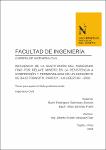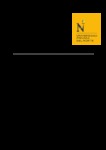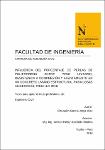Mostrar el registro sencillo del ítem
Influencia de la sustitución del agregado fino por relave minero en la resistencia a compresión y permeabilidad de un concreto de bajo tránsito, Parcoy - La Libertad - 2018
| dc.contributor.advisor | Vásquez Díaz, Alberto Rubén | |
| dc.contributor.author | Rodríguez Salirrosas, Jhosver | |
| dc.contributor.author | Ulloa Sánchez, Frank | |
| dc.date.accessioned | 2019-02-05T19:40:46Z | |
| dc.date.available | 2019-02-05T19:40:46Z | |
| dc.date.issued | 2019-01-10 | |
| dc.identifier.citation | Rodríguez, J., & Ulloa, F. (2018). Influencia de la sustitución del agregado fino por relave minero en la resistencia a compresión y permeabilidad de un concreto de bajo tránsito, Parcoy - La Libertad - 2018 [Tesis de licenciatura, Universidad Privada del Norte]. Repositorio de la Universidad Privada del Norte. Recuperado de https://hdl.handle.net/11537/14827 | es_PE |
| dc.identifier.other | 624.1834 RODR/I 2018 | es_PE |
| dc.identifier.uri | https://hdl.handle.net/11537/14827 | |
| dc.description.abstract | La presente tesis de investigación incentiva al aprovechamiento de residuos mineros comúnmente denominado relave minero, el mismo que se encuentra almacenado en la Presa de Relaves Alpamarca, ubicado en el distrito de Parcoy, Pataz. El relave es generado por el proceso de flotación, más no por el proceso de Cianuración. Se propone como una opción para ser usado en reemplazo del agregado fino para la elaboración de concreto de bajo tránsito (F’c=175 kgf/cm2) como aplicación a una estructura determinada, del mismo modo se presenta como una alternativa eficiente de solución a los problemas por contaminación ambiental, que es generada por los procesos que realizan las empresas mineras, para la obtención de mineral aurífero. La problemática del proyecto nace debido a que la industria minera genera gran cantidad de relave y necesita mucho espacio para su disposición y almacenaje. Por ello, se propone utilizar este relave para sustituir al agregado fino. Los porcentajes que se estudiaran son 5%, 10% y 15% con respecto a la arena. En la presente investigación se analizará la influencia de la sustitución de la arena por relave en la resistencia a compresión del concreto, según la NTP 339.034 y penetración de agua bajo presión, según la Norma Europea UNE-EN 12390-8 para medir la permeabilidad del concreto. Del mismo modo, los diferentes materiales utilizados en la investigación fueron analizados para conocer sus propiedades físicas y mecánicas, de acuerdo a las Normas Técnicas Peruanas, con respecto al diseño de mezcla se procedió de acuerdo a la Norma ACI 211. Los resultados obtenidos de los ensayos a compresión y penetración del agua aplicados a concretos de bajo tránsito, demuestran que para un 10% de sustitución de agregado fino por relave minero, la dosificación es ideal para lograr un mejor comportamiento a diferencia del resto de los porcentajes evaluados, es decir, la resistencia a compresión del concreto se incrementa a un 10.07% y la permeabilidad del concreto se reduce a un 51.61% con respecto del concreto patrón y de los porcentajes de 0%, 5% y 15%. Nuestros resultados expresan que es posible lograr los beneficios del uso del relave en el concreto, descritos en el párrafo anterior, logrando reducir los costos de elaboración y disminuyendo el impacto en el medio ambiente. De este modo, la investigación logra una propuesta o alternativa que permite reciclar o reutilizar el relave minero sin afectar al medio ambiente. | es_PE |
| dc.description.abstract | This research thesis encourages the use of mining waste commonly called mine tailings, which is stored in the Alpamarca Tailings Dam, located in the district of Parcoy, Pataz. The tailings are generated by the flotation process, but not by the process of cyanidation. It is proposed as an option to be used as a replacement for the fine aggregate for the manufacture of low-traffic concrete as an application to a specific structure, in the same way it is presented as an efficient solution alternative to the problems due to environmental contamination, which is generated by the processes carried out by mining companies to obtain gold ore. The problem of the project was born because the mining industry generates a lot of tailings and needs a lot of space for its disposal and storage. Therefore, it is proposed to use this tail to replace the fine aggregate. The percentages to be studied are 5%, 10% and 15% with respect to the sand. In the present investigation the influence of the substitution of the sand by tailings in the compressive strength of the concrete, according to the NTP 339.034 and penetration of water under pressure, according to the European Standard UNE-EN 12390-8 to measure the permeability of the concrete. In the same way, the different materials used in the investigation were analyzed to know their physical and mechanical properties, according to the Peruvian Technical Standards, with respect to the design of the mixture, proceeded according to the ACI 211 Standard. The results obtained from the compression and water penetration tests applied to concrete with low traffic, show that for a 10% substitution of fine aggregate by mining tailings, the dosage is ideal to achieve a better behavior unlike the rest of the percentages evaluated, that is, the compressive strength of the concrete increases to 10.07% and the permeability of the concrete is reduced to 51.61% with respect to the standard concrete and the percentages of 0%, 5% and 15%. Our results express that it is possible to achieve the benefits of the use of the tailings in the concrete, described in the previous paragraph, managing to reduce the costs of elaboration and diminishing the impact on the environment. In this way, the research achieves a proposal or alternative that allows to recycle or reuse the mining tailings without affecting the environment. | es_PE |
| dc.description.uri | Tesis | es_PE |
| dc.format | application/pdf | es_PE |
| dc.format | application/msword | |
| dc.language.iso | spa | es_PE |
| dc.publisher | Universidad Privada del Norte | es_PE |
| dc.rights | info:eu-repo/semantics/openAccess | es_PE |
| dc.rights.uri | https://creativecommons.org/licenses/by-nc-sa/4.0/ | |
| dc.source | Universidad Privada del Norte | es_PE |
| dc.source | Repositorio Institucional - UPN | es_PE |
| dc.subject | Concreto | es_PE |
| dc.subject | Resistencia de materiales | es_PE |
| dc.subject | Resistencia a la compresión | es_PE |
| dc.title | Influencia de la sustitución del agregado fino por relave minero en la resistencia a compresión y permeabilidad de un concreto de bajo tránsito, Parcoy - La Libertad - 2018 | es_PE |
| dc.type | info:eu-repo/semantics/bachelorThesis | es_PE |
| thesis.degree.grantor | Universidad Privada del Norte. Facultad de Ingeniería | es_PE |
| thesis.degree.level | Título Profesional | es_PE |
| thesis.degree.discipline | Ingeniería Civil | es_PE |
| thesis.degree.name | Ingeniero Civil | es_PE |
| dc.publisher.country | PE | es_PE |
| dc.subject.ocde | https://purl.org/pe-repo/ocde/ford#2.01.01 | es_PE |
| thesis.degree.program | Pregrado | es_PE |
| dc.description.sede | Trujillo San Isidro | es_PE |
| renati.advisor.dni | 40385695 | |
| renati.advisor.orcid | https://orcid.org/0000-0001-9018-5763 | es_PE |
| renati.author.dni | 71753966 | |
| renati.author.dni | 48262692 | |
| renati.discipline | 732016 | es_PE |
| renati.juror | Diestra Cruz, Heberth | |
| renati.juror | Azañedo Medina, Wiston | |
| renati.juror | Rivera Muñoz, Melving | |
| renati.level | https://purl.org/pe-repo/renati/level#tituloProfesional | es_PE |
| renati.type | http://purl.org/pe-repo/renati/type#tesis | es_PE |
Ficheros en el ítem
Este ítem aparece en la(s) siguiente(s) colección(ones)
-
Tesis [1646]









